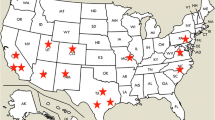Abstract
Introduction
In the developing world, occupation has been identified as a risk factor for snake bite. Such an association has not been described in the USA. The objective of this study was to describe the epidemiology and clinical manifestations of occupational snake bite in patients reported to the ToxIC North American Snakebite Registry (NASBR).
Methods
This was a prospective case series of patients reported to the ToxIC NASBR between January 1, 2014 and November 5, 2015. Variables collected included snake species, patient demographics, date and location of exposure, occupation, bite location, clinical manifestations, and management.
Results
Of 180 adult snake bites reported, 25 (13.9 %; 95 % CI 9.2–19.8 %) were occupational in nature. Rattlesnake envenomations were common (80 %). Most snake bites (96 %) occurred in men. Occupations most associated with snake bite were landscaping (28 %) and working directly with snakes (24 %). Fifty-six percent of bites occurred in an outdoor work environment. Seventy-six percent of envenomations were to the upper extremities. Intentional interaction occurred in 40 % of cases, all of which sustained finger envenomations. No cases presented with apparent acute ethanol intoxication.
Conclusions
The majority of occupational snake bites occurred in men working outdoors and were unintentional injuries. Bites involving the upper extremity tended to result from intentional interactions. Acute ethanol intoxication did not appear to be involved with occupational envenomations.



Similar content being viewed by others
References
O’Neil ME, Mack KA, Gilchrist J, Wozniak, EJ: Snakebite injuries treated in United States emergency departments, 2001–2004. Wilderness Environ Med, 2007 cited 2016 Mar 26;18:281–287. Available from Pubmed: http://www.ncbi.nlm.nih.gov/pubmed/18076294.
Lavonas EJ, Ruha AM, Banner W et al. Unified treatment algorithm for the management of crotaline snakebite in the United States: results from an evidence-informed consensus workgroup. BMC Emerg Med, 2011[cited 2016 Mar 26];11:1–15. Available from Pubmed: http://www.ncbi.nlm.nih.gov/pubmed/21291549
Ruha A, Pizon AF. Native (US) venomous snakes and lizards. In: Hoffman RS, Howland MA, Lewin NA, Nelson LS, Goldfrank LR, editors. Goldfrank’s toxicologic emergencies, 10e. New York: McGraw-Hill; 2015. p. 1537–46.
Warrick BJ, Boyer LV, Seifert SA. Non-native (exotic) snake envenomations in the U.S.; 2005–2011. Toxins, 2014 [cited 2016 Mar 26];6:2899–2911. Available from Pubmed: http://www.ncbi.nlm.nih.gov/pubmed/25268980.
Downey DJ, Omer GE, Moneim, MS. New Mexico rattlesnake bites. Demographic review and guidelines for treatment. J Trauma,1991 [cited 2016 Mar 26];31:1380–1386. Available from Pubmed: http://www.ncbi.nlm.nih.gov/pubmed/1942147.
Curry SC, Horning D, Brady P et al. The legitimacy of rattlesnake bites in Central Arizona. Ann Emerg Med, 1989 [cited 2016 Mar 26];18:658–663. Available from Pubmed: http://www.ncbi.nlm.nih.gov/pubmed/2729691
Wingert WA, Chan, L. Rattlesnake bites in southern California and rationale for recommended treatment. West J Med, 1988 [cited 2016 Mar 26];148:37–44. Available from Pubmed.
Tanen DA, Ruha AM, Graeme KA, Curry, SC. Epidemiology and hospital course of rattlesnake envenomations cared for at a tertiary care referral center in Central Arizona. Acad Emerg Med, 2001[cited 2016 Mar 26];8:177–182. Available from Pubmed: http://www.ncbi.nlm.nih.gov/pubmed/11157295
Pezzullo, JC. Interactive Statistics Pages [Internet]. Washington DC: [Publisher unknown]; [Year unknown] [updated 2009 May 25; cited 2016 April 16]. Available from: http://statpages.info/confint.html
Bhalla G, Mhaskar D, Agrawal A. A study of clinical profile of snake bite at a tertiary care center. Toxicol Int, 2014:21:203–208. Available from Pubmed: http://www.ncbi.nlm.nih.gov/pubmed/25253932
Acknowledgments
The authors express gratitude to the staff at the American College of Medical Toxicology (ACMT) for support of the North American Snakebite Registry (NASBR) within the ToxIC Registry project. We would also like to thank the members of the 2015 ToxIC Snakebite Study (TICSS) group: Anna Arroyo-Plascencia, Vikhyat S. Bebarta, Michael C. Beuhler, William Boroughf, Jeffrey Brent, Daniel Brooks, E. Martin Caravati, James D. Cao, Nathan Charlton, Steven Curry, Michael Darracq, William Dribben, Kimberlie Graeme, Spencer Greene, Benjamin Hatten, Kennon Heard, C William Heise, Janetta Iwanicki, Aaron Min Kang, William P Kerns II, Thomas Kibby, Joshua King, Ronald Kirschner, Kurt Kleinschmidt, Ken Kulig, Michael Levine, Rachel Levitan, Elizabeth Moore, Philip Moore, Michael Mullins, Eleanor Oakley, Ayrn O’Connor, Nancy Onisko, Angie Padilla-Jones, Tammy Phan, Frank LoVecchio, Anne-Michelle Ruha, Steven A. Seifert, Daniel J Sessions, Aaron Skolnik, Eric Smith, Meghan Spyres, An Tran, S. Eliza Halcomb, Evan S. Schwarz, Shawn M. Varney, Rais Vohra, Brandon J. Warrick, Sam G. Wang, Paul Wax, and Brian J. Wolk.
Author information
Authors and Affiliations
Corresponding author
Ethics declarations
Conflicts of Interest
Authors Meghan Spyres MD, Anne-Michelle Ruha MD, Steven Seifert MD, Nancy Onisko DO, Angela Padilla-Jones RN, and Eric Smith MSIS have no conflicts of interest to declare.
Funding
There was no direct funding for this project.
BTG International sponsored an unrestricted grant to ACMT for the NASBR registry.
Rights and permissions
About this article
Cite this article
Spyres, M.B., Ruha, AM., Seifert, S. et al. Occupational Snake Bites: a Prospective Case Series of Patients Reported to the ToxIC North American Snakebite Registry. J. Med. Toxicol. 12, 365–369 (2016). https://doi.org/10.1007/s13181-016-0555-7
Received:
Revised:
Accepted:
Published:
Issue Date:
DOI: https://doi.org/10.1007/s13181-016-0555-7



